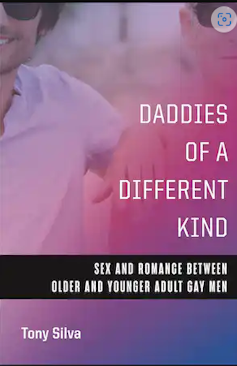
Reprinted with permission from The Conversation October 3, 2023
The term “daddy” has exploded in popularity in recent years. Actor Pedro Pascal was recently crowned the internet’s daddy. There is an app called Dream Daddy where players can date a daddy. Saturday Night Live even ran a skit about daddies.
While there is no shortage of discussions about daddies, there is little research about what the term means to the men who are classified as daddies themselves.
My new book, Daddies of a Different Kind: Sex and Romance Between Older and Younger Adult Gay Men, investigates this topic. I talked to 39 men in their 40s, 50s and 60s who saw themselves as daddies, and 26 men in their 20s and 30s who liked dating older men. I focused on gay and bisexual men because they are more likely to form partnerships with large age gaps than any other group in the western world.
What is a daddy?
Many of the men I talked to agreed that daddies were experienced, stable, had leadership abilities and nurtured and mentored younger adult men. This mentorship involved a range of topics, from how to come out to family to how to advance in their careers. The connection between older and younger adult men was not just physical, it was emotional too.
As Tomas (44) explained, a “daddy is typically somebody who is an older man who feels comfortable being with a younger person and is there to help and support them and work through things with them.” This tender connection existed in many of the relationships men formed, from casual dating to friends-with-benefits to romantic partnerships.
In contrast to stereotypes, there was little evidence of widespread power differentials that harmed either older or younger adult men. One reason why is that men viewed nurturance of younger adult men as key to daddyness.
Mateo (55) noted: “You want to leave somebody in better shape after you’re not with them. So as a daddy you want the best for that person throughout the relationship and even afterwards.”
Older men’s daddy consciousness developed in midlife. It usually began in response to interest from younger adult men. “I didn’t expect to be a daddy, it just kind of happened,” Jordy (57) explained. “It was gradual. They started [calling me daddy] in my early 40s and probably when I was around 45, 46, I accepted the role.” Daddyness is not just a state of mind. Most men agreed that daddyness is connected to age.
Why are younger men interested in daddies?
In addition to mentorship, younger adult men described a variety of reasons they enjoyed the company of older men. These reasons were, notably, not financial. Michael (30) described, “I’ve never been one to ask for money or to gain benefit from it. I’m financially stable. I’m my own man.”An SNL skit about daddies. The term has increased in popularity in recent years.
Of course, sugar daddies do exist among both heterosexuals and LGBTQ people. Yet the younger adult men I talked to desired older men for their emotional maturity and other non-financial traits.
“I’ve noticed that I’m drawn to older guys mostly because there’s an emotional maturity there,” Joshua (23) offered. DaShawn (27) agreed: “Sometimes I feel like people my own age are immature.” Overall, the younger adult men felt like they connected better with older men.
Unsurprisingly, they also described physical attraction to older men. William (29) noted: “I love gray hair, I like a beard. Signs of age I find are things that are attractive. I like men that wear glasses. Those sorts of physical features I find really are the things that draw me most.” Younger adult men did not desire older men despite their appearance, but in part because of it.
Connecting generations
The connections men formed were both physical and social. Older-younger pairings between adults help to connect different generations of gay and bisexual men. “I feel like I am creating a connection with previous generations of queer people. I feel like that’s part of being a daddy for me,” Graham (51) explained.
Younger adult men can learn from older men what life was like for gay and bisexual men in prior decades. They can also learn about practices that are more common among gay men, including open relationships.
LGBTQ people comprise a small share of the population: 7.2 per cent in the United States and four per cent in Canada. For this reason, one may expect that age gaps are more common among same-sex couples simply because there are fewer available partners.
It is true that age gaps are less common among different-sex (woman-man) couples than same-sex couples. Yet it is also true that age gaps are more common among man-man couples than woman-woman couples, even though both groups face a similarly small dating market. This shows that gay and bisexual men are more open to, or interested in, older-younger pairings between adults than other groups.
For many men, older-younger pairings between adults are an important part of what it means to be a gay or bisexual man today. In many western countries, LGBTQ+ people enjoy more legal rights and social inclusion than they did even 10 years ago. Yet unique aspects of their cultural life have continued, including a greater likelihood to form older-younger pairings between adults. Given that dating apps make it easier to meet adults much older or younger than oneself, these pairings will likely continue for a while.
Tony Silva has received funding from the Sexualities Project at Northwestern University (SPAN) and the Graduate School at Northwestern University.
Tony Silva is an Assistant Professor of Sociology, University of British Columbia. You can follow Tony on Twitter at @Sociology_Silva

Comments